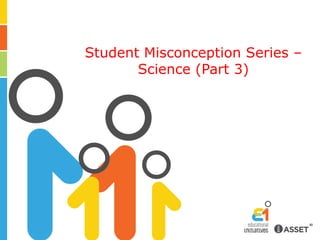
Student Misconception Series – Science (Part 3)
- 1. Student Misconception Series – Science (Part 3)
- 2. Do your Student Learn or Mug up ? Students of all ages seem to have a mind of their own when it comes to responding to any situation or performing any task. As teachers, most of us go back home thinking that our students have understood every concept that we teach them. It is only when we test them that we find that some concepts have not been understood as clearly as they should have been. It is this desire to understand student thinking that prompted us to examine ASSET questions of the past rounds, in Science, examining the most common wrong answers to understand what could have made students select the options they did.
- 3. Scientificliteracy & Scientificmethods Class 5
- 5. Why was the Question asked? This question was designed to test whether students will be able to identify the appropriate set-up required to carry out the experiment based on the changes in given factors. What did students answer ? Only 34.6% of the students answered correctly, whereas 27.4% chose the most common wrong answer, B. Possible reason for choosing A: These students are simply choosing the option that has the same temperature as the image in the question with a different arrangement of the cloth. Possible reason for choosing B: These students are probably just choosing the option that shows the cloth in a higher ambient temperature, without paying attention to how the cloth is folded or placed on the clothesline. Possible reason for choosing D: These students are probably making a random guess or are choosing a picture which has the same temperature as the image in the question.
- 6. Learnings Experiment design is one of the most important skills in science that should be instilled in students from primary grades. The most important thing to be kept in mind while designing an experiment is to keep all the factors, apart from the one being tested, constant, so as to make sure that no other factor interferes in the results. In this question, students are expected to understand that the temperature is the only factor that needs to be changed. The most common wrong answer is an option which shows the change in temperature needed for the experiment, but shows changes in other factors as well. This indicates that they may not have understood the purpose of the experiment.
- 7. Students might be confused when asked to design an experiment on their own for the first time. This can be helped by giving the students a basic framework of factors involved and asking how they would manipulate these factors to test something. Discuss the ASSET question and make sure students are clear about what needs to be tested in the experiment. List down the factors that change in the question to help students compare them easily. Ask students how each difference will impact the results of the experiment. For example: if option B is considered, then since both factors are different, will it be a valid way to check whether ONLY the temperature is affecting the rate of drying? Asking students such questions will help them realize which factors need to remain the same for the experiment to be valid.
- 8. Contd… After they have started thinking along the required lines, give students different experimental set-ups and ask them to judge whether it is a good one or not to test a particular factor. For example: • Do you think the rockets shown can be used to check whether differently-shaped rockets can fly differently? Ask students to explain why they think the set-up is a good or bad one. Also ask them to think about environmental factors and things that could go wrong in an experiment. Finally, they can be asked to design their own experiments to check simple things like whether the rate of evaporation of water differs indoors and outdoors, or whether seeds sprout differently in conditions of light and darkness.
